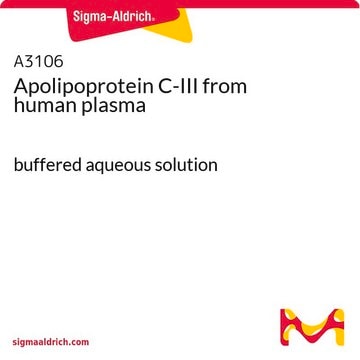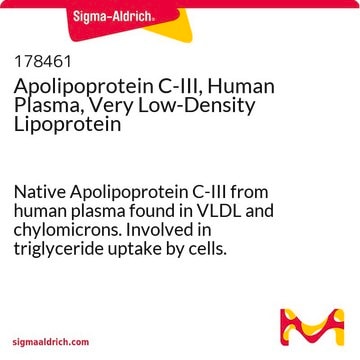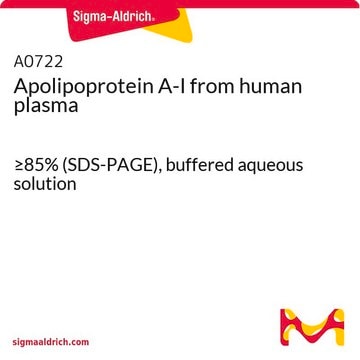ALP60
Apolipoprotein C-III, human
Synonym(e):
ApoCIII
Anmeldenzur Ansicht organisationsspezifischer und vertraglich vereinbarter Preise
Alle Fotos(1)
About This Item
UNSPSC-Code:
12352202
eCl@ss:
32160405
NACRES:
NA.41
Empfohlene Produkte
Biologische Quelle
human
Qualitätsniveau
100
300
Assay
>95% (SDS-PAGE)
Form
liquid
Hersteller/Markenname
Chemicon®
NCBI-Hinterlegungsnummer
UniProt-Hinterlegungsnummer
Allgemeine Beschreibung
Apolipoprotein C-III (APOC3) is a multifaceted protein, localized on circulating triglyceride-rich lipoproteins (TRLs), high-density lipoprotein (HDL), low-density lipoprotein (LDL), and very-low-density lipoprotein (VLDL). The APOC3 gene is mapped to the human chromosome 11q23.3. It is mainly expressed in hepatocytes and to a lesser extent in enterocytes.
Product Source: Human plasma tested negative for HBsAg and HIV-I, HIV-II, HBc and Hepatitis C antibodies. All blood products should be treated as potentially infectious.
Anwendung
Apolipoprotein C-III (APOC3), human has been used to determine its effect reconstituted high-density lipoprotein (rHDL) containing apoA-I. It has also been used to test the effects of the exogenous exchangeable apolipoproteins on low-density lipoprotein (LDL) binding to heparin.
Biochem./physiol. Wirkung
Apolipoprotein C-III (APOC3) is involved in triglyceride metabolism and atherosclerotic lesion formation. It also regulates pathological processes involved in atherosclerosis. APOC3 stimulates hypertriglyceridemia (HTG) through various mechanisms. It functions as a lipoprotein lipase (LPL) inhibitor and also interrupts the clearance of triglyceride-rich lipoproteins (TRLs)-remnants. Mutations in the gene lead to lower plasma glycerides and lower cardiovascular disease risk.
The physiological role of Apo CIII is unknown. It is suggested that Apo CIII may inhibit the activation of lipoprotein lipase by Apo CII.
Physikalische Form
Liquid in 10 mM NH4HCO3, pH 7.4.
Lagerung und Haltbarkeit
Maintain at -20ºC or below in undiluted aliquots for up to 12 months. Avoid repeated freeze/thaw cycles. All blood products should be treated as potentially infectious.
Rechtliche Hinweise
CHEMICON is a registered trademark of Merck KGaA, Darmstadt, Germany
Haftungsausschluss
Unless otherwise stated in our catalog or other company documentation accompanying the product(s), our products are intended for research use only and are not to be used for any other purpose, which includes but is not limited to, unauthorized commercial uses, in vitro diagnostic uses, ex vivo or in vivo therapeutic uses or any type of consumption or application to humans or animals.
Lagerklassenschlüssel
12 - Non Combustible Liquids
WGK
nwg
Flammpunkt (°F)
Not applicable
Flammpunkt (°C)
Not applicable
Analysenzertifikate (COA)
Suchen Sie nach Analysenzertifikate (COA), indem Sie die Lot-/Chargennummer des Produkts eingeben. Lot- und Chargennummern sind auf dem Produktetikett hinter den Wörtern ‘Lot’ oder ‘Batch’ (Lot oder Charge) zu finden.
Besitzen Sie dieses Produkt bereits?
In der Dokumentenbibliothek finden Sie die Dokumentation zu den Produkten, die Sie kürzlich erworben haben.
Jan Borén et al.
Frontiers in endocrinology, 11, 474-474 (2020-08-28)
Cardiovascular disease (CVD) is the leading cause of death globally. It is well-established based on evidence accrued during the last three decades that high plasma concentrations of cholesterol-rich atherogenic lipoproteins are causatively linked to CVD, and that lowering these reduces
Rayabarapu Pranavchand et al.
Lipids in health and disease, 16(1), 116-116 (2017-06-15)
Given the characteristic atherogenic dyslipidemia of south Indian population and crucial role of APOA1, APOC3, APOA4 and APOA5 genes clustered in 11q23.3 chromosomal region in regulating lipoprotein metabolism and cholesterol homeostasis, a large number of recently identified variants are to
Kyung-Hyun Cho
Molecules and cells, 27(3), 291-297 (2009-03-28)
Apolipoprotein (apo) C-III is a marker protein of triacylglycerol (TG)-rich lipoproteins and high-density lipoproteins (HDL), and has been proposed as a risk factor of coronary heart disease. To compare the physiologic role of reconstituted HDL (rHDL) with or without apoC-III
Alison B Kohan
Current opinion in endocrinology, diabetes, and obesity, 22(2), 119-125 (2015-02-19)
The purpose of this article is to summarize the recent epidemiological, basic science, and pharmaceutical research linking apolipoprotein C-III (apoC-III) with the development and treatment of cardiovascular disease (CVD). ApoC-III is an important emerging target linking hypertriglyceridemia with CVD. ApoC-III
Jihoe Kim et al.
BMB reports, 43(8), 535-540 (2010-08-28)
Patients with hemorrhagic fever with renal syndrome (HFRS) often exhibit altered serum lipid and lipoprotein profile during the oliguric phase of the disease. Serum lipid and lipoprotein profiles were assessed during the oliguric and recovery phases in six male patients
Unser Team von Wissenschaftlern verfügt über Erfahrung in allen Forschungsbereichen einschließlich Life Science, Materialwissenschaften, chemischer Synthese, Chromatographie, Analytik und vielen mehr..
Setzen Sie sich mit dem technischen Dienst in Verbindung.







